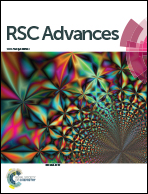Highly flexible all-solid-state supercapacitors based on carbon nanotube/polypyrrole composite films and fibers†
Abstract
Flexible all-solid-state film-shaped supercapacitors in both film and fiber configurations have been fabricated by depositing polypyrrole (PPy) onto freestanding carbon nanotube (CNT) films and also by directly twisting the composite films into thin fibers. These CNT/PPy films and fibers maintain a porous structure in which PPy is coated on individual CNTs as well as their interconnections. The specific capacitance of a solid CNT/PPy composite film supercapacitor reaches 139.2 F g−1 (27.8 mF cm−2, 10 mV s−1) and 331.4 F g−1 (5 mV s−1) in a solid fiber supercapacitor when directly twisting the CNT/PPy composite film into a fiber, which is attributed to the uniform PPy coating throughout the CNT film and both inside and outside of the fiber. These devices show high stability during 10 000 charge and discharge cycles, and good flexibility under bending and twisting. Our CNT/PPy film and fiber-shaped supercapacitors have many potential applications in flexible electronics and energy storage textiles.


 Please wait while we load your content...
Please wait while we load your content...